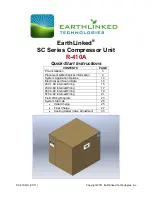
POWX1735
EN
Copyright © 2014 VARO
P a g e
|
6
www.varo.com
6.3
Things you should know
To avoid overheating of the electric motor, this compressor is designed for intermittent
operation as indicated on the technical dataplate. In the case of overheating, the thermal
cutout of the motor trips, automatically cutting off power when the temperature is too high.
The motor restarts automatically when normal temperature conditions are restored.
To facilitate restart of the compressor, in addition to the operations indicated, it is
important to return the button of the pressure switch to the OFF position and then to ON
again. (Figures 2-3-4)
Single-phase versionns are fitted with a pressure switch equipped with a delayed closing
air discharge valve which facilitates start-up of the motor. Therefore venting of air from this
valve for a few seconds with the receiver empty is normal.
All the compressors are fitted with a safety valve that is tripped in the case of
malfunctioning of the pressure switch in order to assure machine safety.
When fitting a tool, the flow of air in output must be switched off.
When using compressed air, you must know and comply with the safety precautions to be
adopted for each type of application (inflation, pneumatic tools, painting, washing with
water-based detergents onlt, etc.).
7 START-UP AND USE
Fit the wheels and foot (or the suckers according to model) following the instructions
provided in the packaging.
Check for correspondence between the compressor plate data with the actual
specifications of the electrical system. A variation of ± 10% with respect of the rated value
allowed.
Insert the plug of the power cable in a suitable socket (fig.6) checking the the button of the
pressure switch located on the compressor is in the OFF “O” position.
For lubricated models, check the oil level using the rod included in the oil fuel plug (figures
7a-7b-7c) and if necessary top up.
At this point, the compressor is ready for use.
Operating on the switch of the pressure switch (fig. 3), the compressor starts, pumping air
into the receiver through the delivery pipe.
When the upper calibration value (set by the manufacturer) has been reached, the
compressor stops, venting the excess air present in the head and in the delivery pipe
through a valve located under the pressure switch.
This facilitates subsequent restart due to the absence of pressure in the head. When air is
used, the compressor restarts automatically when the lower calibration value is reached
(2bar between upper and lower).
The pressure in the receiver can be checked on the gauge provided (fig.8).
The compressor continues to operate according to this automatic cycle until the switch of
the pressure switch is turned.
Always wait at least 10 seconds from when the compressor has been switched off before
restarting this.
All compressors are fitted with a pressure reducer. Operating on the knob with the tap
open (pulling it up and turning it in a clockwise direction to increase the pressure and in a
counterclockwise direction to reduce this (fig 9), air pressure can be regulated so as to
optimize use of pneumatic tools. After setting the value required, push the knob to fasten
this (fig. 9B). on some versions, the ring-nut underneath must be tightened to fasten the
knob (figures 9c-9d)
The value set can be checked on the gauge.
Please check that the air consumption and the maximum working pressure of the
pneumatic tool to be used are compatible with the pressure set on the pressure regulator
and with the amount of air supplied by the compressor.




























